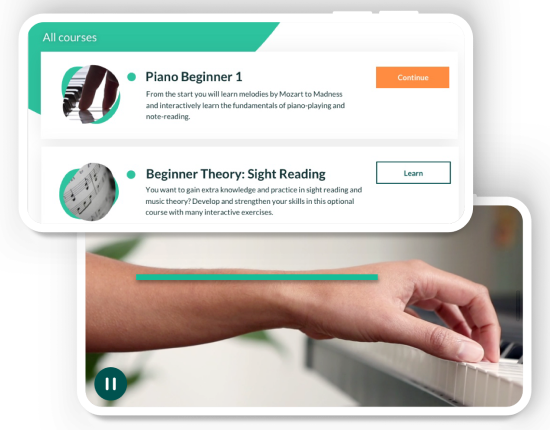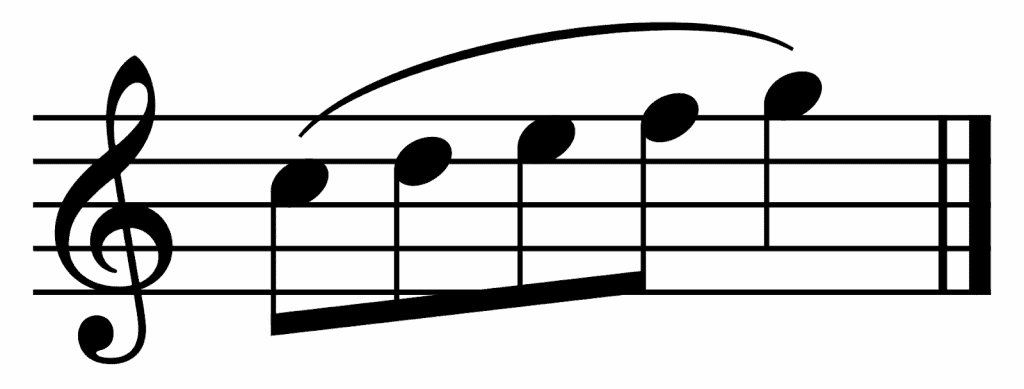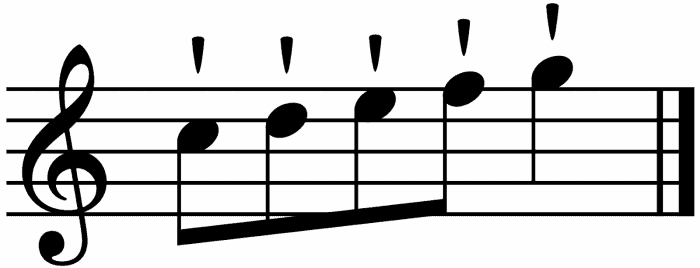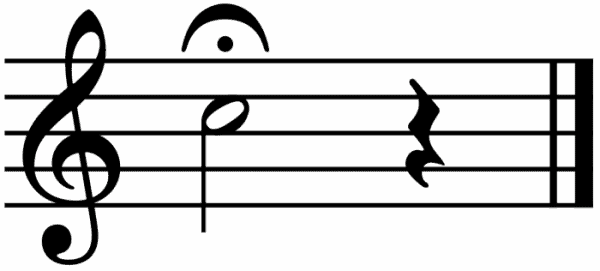Table of Contents
Articulations are a category of terms that define not what notes we play on piano, but how we play those. You’ve probably heard the phrase, “It’s not what you say, but how you say it that matters”. This is exactly the same for music and using an accent mark. The notes that you play are much less important than how you play them. The same musical phrase can change from dramatic, to sweet, to aggravated in a second, all just by changing the type of articulation we use.
Key takeaways
- Articulations control how we play things, not which notes we play
- You can combine many different types of articulations at the same time
- Different types of articulation require using the foot pedal on the piano
- Some articulations control how loud you play, and some control how you play notes
- Using articulations during practice can give life to boring exercises

What is articulation in music?
Some articulations only apply to the first note, some apply to multiple notes and some apply only on one note or on the accented note, or between a group. We use articulations all the time in music, and some will apply only to specific instruments like woodwind players or pianists, or stringed instruments. We can find examples of these in the music you would find during online piano lessons.
Definition of articulation
Piano articulation refers to little marks that change how we read the music. In written music, articulation is often called the punctuation of music, because they don’t change the musical notes that are played, but they do control how they are performed. The music notation over all the notes will not change because of the articulation – you will still play the same pitch, but the different articulation markings will create a different set of phrasing.
Here is an example of an incredible piece by Ravel, his Tocatta. The pianist plays the entirety of the piece using the articulation staccato, notated in the beginning.
Different articulations can help shape the phrasing of music. Some will cause you to play notes with a shortened duration, or to play the full value of another note, or will cause brass and woodwind players to use a specific type of reed or breathing. Some further still will control the dynamic level of your playing. Music articulation is a very important concept for you to learn and master to play piano and understand piano theory.
Categories of articulation
We can easily split note articulation types into categories, some based on instruments or some based on piano playing. We will look at categories based on how they accent notes, change the volume of our placing, piano keys, or how they change the technique we use.
Slurs and legato
These are phrase marking articulations. We use slurs in order to indicate a change in phrase for a whole group of notes, but legato works for everything in a big phrase. It can be helpful to write a legato sign instead of slurs to keep your music clean. On the other hand, slur lines very clearly indicate to the musician which part of the music is most important, where here you can see the group of notes is all leading naturally toward the highest note. We can tie between two single notes to change the length of the piano notes played.
Slur
A slur is a type of piano articulation that changes a group of notes. The different effect here is changing how we play the phrase. We blur all of the notes of the phrase together. This causes the notes to have very little space in between them, making a very interesting sound. A musician will play a slur so that the notes all seem interconnected. You can easily create this sound on your piano by depressing your foot pedal, and now all of the notes will sound like they are connected. 
Legato
Legato is a playing technique that changes how you approach all notes in a phrase, or a group of notes. On some instruments this will mean that you play with a different type of bowing technique, or that a musician will smooth out all of the individual plucks of the instrument. On piano, you can try to create a sense of smoothness between every note.
Staccato, staccatissimo, and portato
We can use articulations to change the sound and timbre of our instrument, or any melody in music we are playing. We can use articulation to change groups of notes or we can use articulations to change the length a note is played. Where with legato and slurs we perform smoothly, this group of articulation is very different.
Staccato
A staccato mark is a small dot that lives on top of a single note head. It makes our phrases sound very different. For that specific note, we perform it short and separated. Staccato comes from the Italian ‘to detach’, so the single note becomes detached from the group.
Staccatissimo
Staccatissimo is also an Italian term and is an extreme version of the staccato dot. Musicians will play this like a staccato but even more separated. These are the most detached phrases you can possibly make. Note that both staccatissimo and staccato change the sound of the note played, but they do not change the duration of the rhythm. Though it is written shortly, it still is played for the same rhythm it was written for. 
Portato
Portato is an interesting and difficult definition of articulation. When written, it applies to a group of notes, both a staccato dot and a slur. It is somewhat of an in-between place between two different concepts, half legato and half separated. It marks the phrase, but shows specific note articulation.
Accents, sforzando, marcato, tenuto, and fortepiano
This group of articulation marks almost always only applies to one. They serve to create points of interest, end phrases, or shock audience members with big bombastic changes in dynamics. Oftentimes these couldn’t be written with any specific combination of other articulation, so a special one had to be created. These are less common, but still important to learn about.
Accents
Accents are an articulation that applies only to one note, and they change the volume at which something is played. They can combine with legato like staccato does, but when written they change how the musician attacks a note. Often accents will show a musician where in the written music to end a phrase, or in vocal music which word to put emphasis on. In piano music we find accents often in the left hand or on chords to play, especially at the beginnings of new sections. This example has emphasis on the first and final note of the phrase, so this results in the note slightly louder, but they are not cut short like when played with a staccato dot.
Sforzando
Sforzando is one of the most unique accent marks. This symbol is easy to recognize because it is a combination of an S, an F, and a Z, found in the word. It means that the music will be played very loudly and then reduced down to an extreme quiet. A shock, an explosion, a movement of great interest. These are particularly difficult to play on the piano, and are often found in advanced piano music. Especially when hands are together, stomping on big chords in the low register of the instrument, these are not played staccato unless written. 
Marcato
Like most music terms, this comes from the word in Italian to mean ‘marked’. This means things marked marcato are intended to be played slightly louder than the next note, but not left to be loud for the entire duration of the rhythm. Marcato is most commonly written for string instruments, but you will see it in piano music quite a lot. The next note is going to be quieter than the first note, which has our articulation.
Tenuto
Tenuto means that the note is meant to be played for the entire duration of the rhythm written. Oftentimes musicians will leave one note to the next note a little early, in order to make a phrase more interesting. This is commonplace and assumed by all composers, so when a composer really wants their performer to follow the music exactly, a tenuto is written. 
Fortepiano
A fortepiano is exactly what it says in the name. A quick sudden burst of playing something very loudly, then immediately back to playing piano. Almost like a shock to the system. Articulation marks like this are used constantly in advanced and intermediate piano literature, and mastering them is part of truly being a great musician. 
Fermatas
Fermatas deserve a category all to themselves because they are very unique. Fermatas are often called a ‘pause’. These have two understood definitions: when playing in an ensemble with a conductor, the fermata indicates the performers to hold and wait for a signal from the director. This means that the phrasing structure, usually between movements, is being controlled by one person for a group of people.
The other version of a fermata is for when you’re interpreting music as a solo performer. The common understanding of a pause is that you need to not totally stop, merely wait for a second. Thus the name pause. A practical use for this term is to then double the length of the written rhythm. This would mean a half note would normally be two beats, but with an attached pause would then become 4 beats, or a whole note. This allows composers to increase the length of a piece of music without making it very difficult to read.
Articulation technique on the piano
You will notice that a lot of these techniques can be interpreted in many different ways, and are very situational. That is very true, and many pieces will use combinations of all types of musical instructions and articulation. This is not something to be afraid of, but instead excited by.
As a general rule ties or phrase markings will include some use of the piano pedal, or holding down for a longer time than you would normally. Accent marks will involve you pressing notes very shortly and physically removing your fingers from them, where you might prefer to leave them in one place. Dynamic markings in music and a dynamic articulation will involve a lot of force and control over how you intentionally approach the instrument. Don’t be afraid to really get your hands on the piano and press hard! If It says be loud, be loud!
Using articulation in your piano practice
The best way to add spice and interest to your piano practicing is by involving different types of articulation. If you’re playing boring scales or key signatures why not practice doing it all staccato, or with tenuto markings? Imagine that every other note was written with an accent mark or articulation marks.
You can also imagine that two or more notes are affected by a certain articulation, and then the rest of the notes will not be affected. You can also apply this approach and be different on the ascent than on the descent. This will allow your practicing to really make these different articulation marks mean something to you, and you will eventually be so focused on the articulation, that you will forget about the scale or pattern you were practicing. That is the goal, as it will make you a much better performer and player.
Conclusions
Articulations are so common that every musician has to learn them, just like you have to learn how to speak a phrase in a different way. We can use them to practice, and to breathe new life into any type of music playing that we are doing.
A great place to look for music to apply articulations to, and to find great music to play with articulation already written in is Skoove. You can try the piano app today, and find enough music to practice for a lifetime, and unlock your own creativity.
Author of this blog post:















